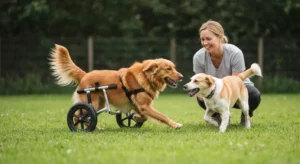As an applied animal behaviorist with over a decade of experience helping families navigate the complexities of pet ownership, I can tell you that the first few weeks with a new animal are the most critical. The way you manage this initial period sets the foundation for your entire relationship and can prevent a host of behavioral issues down the road. Too often, excitement and good intentions lead to overwhelming situations for a new pet, creating anxiety and stress that could have been easily avoided.
Bringing a new pet into your life is a joyful event, but for the animal, it’s a period of immense change and uncertainty. They’ve lost their familiar environment, companions, and routines. Your job is to be their patient, predictable guide through this transition.
This authoritative guide will provide you with five expert-backed, practical tips for introducing a new pet into your home. Following these steps will help ensure a smooth, low-stress transition, fostering a deep and trusting bond from day one.
-
1. Prepare Your Home Before Your Pet Arrives
The Tip: The most common mistake owners make is preparing for their new pet on the day of arrival. A successful introduction begins with meticulous preparation. You must create a “soft landing” by having a dedicated, fully equipped safe space and a pet-proofed home ready and waiting.
The ‘Why’: Imagine being taken to a foreign country where you don’t speak the language and immediately being pushed into a loud, crowded party. This is what it feels like for a pet arriving in a new, unprepared home. A chaotic arrival floods their system with stress hormones like cortisol, putting them in a “fight or flight” state. This initial negative association can be difficult to undo. By preparing in advance, you create a calm, predictable environment that signals safety, allowing your new pet’s nervous system to regulate. This allows them to decompress and begin observing their new world from a place of security, not fear.
The Actionable Advice (The ‘How’):
Your primary goal is to create a “Sanctuary Space” or “Decompression Zone.” This is a dedicated room or a sectioned-off area that will belong exclusively to your new pet for the first few days or even weeks.
- Choose the Location: Select a low-traffic area of your home, like a spare bedroom, office, or a quiet corner of the living room sectioned off with pet gates or an exercise pen. It should be a place where the pet can rest without being constantly disturbed by foot traffic or loud noises.
- Equip the Space (for a Dog):
- A Comfortable Crate: Make the crate an inviting den, not a jail. Furnish it with a soft bed, a safe chew toy, and cover it with a blanket on three sides to create a cozy, cave-like feel.
- Food and Water: Place non-slip bowls for fresh water and food in the space.
- Potty Pads: Even for a house-trained dog, accidents are likely due to stress. Having potty pads available can be a lifesaver.
- Engaging Toys: Provide a few durable chew toys, like a stuffed KONG, to give your dog a positive outlet for stress.
- Equip the Space (for a Cat):
- Litter Box: Place a large, open litter box in a location far away from their food and water. This is a critical point for feline hygiene and comfort.
- Food and Water: As with dogs, place food and water bowls away from the litter box.
- Hiding Spots and Vertical Space: Cats feel safer when they can hide or get up high. Provide a cardboard box on its side and a cat tree or a clear, sturdy shelf.
- Scratching Post: Offer a sturdy scratching post to redirect natural scratching behavior away from furniture from the very beginning.
- Pet-Proof the Rest of the Home: Before your pet arrives, walk through your home and secure anything that could be dangerous. Tuck away electrical cords, move toxic plants, secure trash cans, and put away any small items that could be ingested. This management prevents accidents and removes the need for you to constantly say “no,” which can create a negative dynamic.
-
2. Master the First 72 Hours: The Decompression Protocol
The Tip: Resist the urge to shower your new pet with attention, introduce them to all your friends, or take them to the dog park. The first three days should be exclusively about calm, quiet decompression.
The ‘Why’: Animal rescue professionals often refer to the “3-3-3 Rule”: 3 days to decompress, 3 weeks to learn the routine, and 3 months to truly feel at home. The first 72 hours are a period of sensory overload. Your new pet is processing a tidal wave of new sights, sounds, and smells. Forcing interaction or exploration during this time can be profoundly overwhelming and counterproductive. By keeping their world small and predictable, you allow them to slowly acclimate at their own pace. This builds trust and shows them that you are a source of safety, not a source of pressure.
The Actionable Advice (The ‘How’):
Follow this protocol for a calm and controlled arrival and initial settling-in period.
- The Car Ride Home: Ensure your pet is safely secured in a carrier or with a pet seatbelt harness. Keep the radio low and the atmosphere calm. If it’s a long drive, plan for a quiet potty break in a safe area away from other dogs.
- The Arrival: Before you even enter the house, take your new dog on a brief, calm leash walk around the immediate yard to go potty. For both dogs and cats, bring them directly to their prepared Sanctuary Space. Do not give them a full tour of the house.
- Let Them Be: Once inside their safe space, open the crate or carrier door and let them come out on their own terms. Do not pull them out. Sit quietly in the room with them for a few minutes, then leave them alone to explore their new little world.
- Limit Interaction: For the first 24-48 hours, interactions should be minimal and always initiated by the pet. Enter the room calmly to provide food and fresh water. Sit on the floor and read a book, allowing them to approach, sniff, and retreat as they feel comfortable. Avoid making direct eye contact, reaching for them, or forcing petting. Toss high-value treats near them when they show calm, curious behavior.
- No Visitors: Politely tell friends and family that you need a week or two before introducing the new family member. Your priority is the pet’s well-being, not showing them off.
- Structured Potty Breaks: For dogs, keep potty breaks short, leashed, and business-like. Take them to the same spot each time. This is not the time for long, exploratory walks in the neighborhood, which can be overstimulating.
-
3. Manage Introductions to People and the Environment
The Tip: Gradually and systematically introduce your new pet to the rest of the house and its human inhabitants, using management tools like leashes and baby gates.
The ‘Why’: Giving a new pet unrestricted access to the entire home is a recipe for overwhelm and bad habits. Every new room is a new territory to be assessed for threats and resources. This process is mentally exhausting. Furthermore, uncontrolled interactions with family members, especially children, can lead to fear. A child’s natural exuberance—running, squealing, grabbing—can be terrifying for a nervous animal. A slow, structured approach builds the pet’s confidence, establishes clear boundaries, and teaches family members how to interact appropriately.
The Actionable Advice (The ‘How’):
Think of this as expanding their territory one safe step at a time.
- Leashed Exploration: After the initial decompression period (2-3 days), you can begin short, supervised explorations. Keep your dog on a loose leash and let them sniff one new room at a time for 5-10 minutes. Keep the experience positive with a calm voice and occasional treats for calm behavior. After the session, guide them back to their Sanctuary Space to rest.
- Use Baby Gates: Baby gates are an invaluable tool. They allow your pet to see and hear the household’s daily rhythms from the safety of their space without being physically overwhelmed by the activity.
- Introducing Family Members: Introduce family members one at a time.
- The “No-Talk, No-Touch, No-Eye-Contact” Rule: Instruct family members to initially ignore the pet when they enter the room. This takes all social pressure off the animal.
- Let the Pet Initiate: Have the family member sit down on the floor and toss high-value treats in the pet’s direction. Let the animal be the one to close the distance and solicit attention.
- Teach a Gentle Touch: When the pet does initiate contact, show family members how to pet them calmly on the side of the chest or under the chin. Avoid patting the top of the head, which can be intimidating.
- Special Instructions for Children: This is non-negotiable. Supervise all interactions between your new pet and children. Teach your children to be “pet-friendly statues.” They should sit calmly and let the pet approach them. Teach them to never corner the pet, pull on their tail or ears, or disturb them when they are eating or sleeping in their crate.
-
4. Conduct Meticulous Introductions to Resident Pets
The Tip: Never just “let them work it out.” Introducing a new pet to a resident pet requires a slow, carefully managed process built on scent swapping, visual separation, and neutral territory meetings.
The ‘Why’: A bad first impression between animals can create lasting fear and animosity, leading to a home environment filled with tension, fighting, and stress. The goal of a proper introduction is not instant friendship, but peaceful coexistence. By managing the process, you prevent negative encounters and help the animals build a neutral-to-positive association with each other before they ever have full physical contact. Rushing this is the single biggest and most dangerous mistake when introducing a new pet to a multi-pet household.
The Actionable Advice (The ‘How’):
This process can take days or even weeks. Patience is paramount. Keep the new pet and resident pet completely separate initially, with the new pet confined to their Sanctuary Space.
- Step 1: Scent Swapping (3-5 Days): Animals learn about each other primarily through smell.
- Take bedding, blankets, or soft toys from each pet and place them in the other’s living area. Do this daily. This allows them to get used to the other’s scent in a non-threatening way.
- You can also “scent” your pets by petting one with a sock on your hand, then petting the other with the same sock to mix their scents.
- Step 2: Controlled Visual Introductions (Dog-to-Cat or Cat-to-Cat):
- Use two stacked baby gates in a doorway. This allows them to see each other without being able to make physical contact.
- Conduct short sessions (5-10 minutes) where you feed each pet a high-value meal or special treats on opposite sides of the gate. The goal is to create a positive association: seeing the other animal means good things happen.
- Watch for body language. For cats, look for relaxed postures, slow blinks, and curiosity. Hissing, spitting, or flattened ears means you need to increase the distance and shorten the sessions.
- Step 3: Neutral Territory Meeting (Dog-to-Dog):
- Do not introduce dogs for the first time in the home or yard, which the resident dog considers its territory.
- Enlist a second handler. Meet in a neutral area like a quiet street or park neither dog frequents.
- Begin with a “parallel walk.” Each handler walks a dog on a loose leash, starting on opposite sides of the street. Walk in the same direction so they can see each other from a distance without the pressure of a face-to-face greeting.
- If both dogs are calm (no stiffening, hard staring, or lunging), gradually decrease the distance between them. After 10-15 minutes, you can allow a brief, 3-second “hello” sniff, then call them away cheerfully. Keep the first meeting short and positive.
- Step 4: Supervised Time Together: Only after multiple positive sessions with gates or on parallel walks should you allow supervised, off-leash time in a common area of the house. Keep these initial sessions short and sweet. Provide plenty of resources (multiple water bowls, toys, beds) to prevent competition. Continue to supervise all interactions for several weeks until you are confident in their relationship.
- Step 1: Scent Swapping (3-5 Days): Animals learn about each other primarily through smell.
-
5. Build a Foundation of Routine and Positive Reinforcement
The Tip: Immediately establish a predictable daily routine and commit to using positive reinforcement to shape your pet’s behavior.
The ‘Why’: Structure and predictability are the antidotes to anxiety. A pet who knows when to expect meals, walks, and playtime is a pet who feels secure. Routines help them understand the rules and rhythms of their new life. Simultaneously, positive reinforcement is the language of trust. When you reward the behaviors you want to see (like sitting calmly, going potty outside, or chewing an appropriate toy), you are clearly and kindly communicating your expectations. Conversely, using punishment (yelling, leash corrections, physical intimidation) during this sensitive introductory period will only damage your bond, create fear, and teach your pet that you are unpredictable and scary.
The Actionable Advice (The ‘How’):
- Create a Daily Schedule: Write down a schedule and stick to it as much as possible, especially for the first month.
- Wake-up and Potty Break: Same time every morning.
- Meal Times: Feed your pet at the same time(s) each day.
- Exercise/Walks: Schedule walks or playtime for similar times.
- Training Sessions: Incorporate short (5-minute), fun training sessions into the day.
- Downtime: Ensure the schedule includes plenty of quiet time for the pet to rest and process.
- Embrace Positive Reinforcement:
- Catch Them Being Good: This is the most important concept. Actively look for opportunities to reward your pet for good choices. Is your puppy lying quietly on their bed? Walk over and calmly drop a treat between their paws. Did your new cat use the scratching post? Tell them “Good job!” in a happy voice and give them a chin scratch.
- Use High-Value Rewards: Especially in the beginning, use rewards that your pet finds truly motivating. This might be small pieces of chicken, cheese, or a special toy—not just their regular kibble.
- Ignore or Redirect Unwanted Behavior: If your new puppy nips at your hand, yelp and briefly withdraw attention. If your cat scratches the sofa, don’t yell; calmly redirect them to their scratching post and reward them when they use it. This teaches them what to do instead, which is far more effective than punishing them for what not to do.
- Create a Daily Schedule: Write down a schedule and stick to it as much as possible, especially for the first month.
Bringing a new companion into your life is a journey. By prioritizing preparation, patience, and positivity, you are not just managing a transition—you are building the bedrock of a trusting, joyful relationship that will last a lifetime. Be patient with your new pet, and just as importantly, be patient with yourself. You are both learning a new dance, and with these steps, you’ll be in perfect sync in no time.












